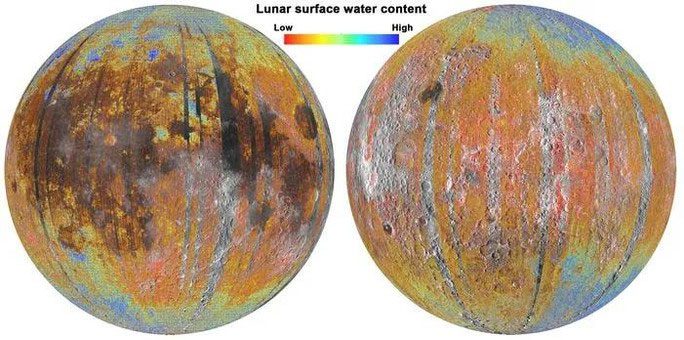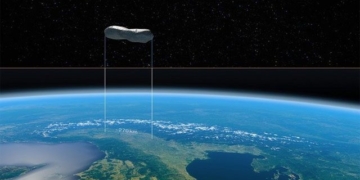Not only does Earth have an extremely long tail in the region where sunlight cannot reach, but it also uses this tail to transform another celestial body.
A new discovery by a team of scientists led by Dr. Shuai Li from the School of Earth and Ocean Sciences at the University of Hawaii (USA) may explain the long-standing mystery of water signs on the Moon.
According to Space, the research team discovered that Earth possesses a long and powerful plasma tail that is invisible to the naked eye.

Water map on the Moon – (Photo: NATURE ASTRONOMY).
This tail originates from the planet’s unique “magnetic shield,” which protects the atmosphere and all living beings from harsh cosmic radiation: the magnetosphere.
We have an aggressive parent star that continuously releases high-energy solar wind. When the solar wind strikes the magnetosphere, this magnetic shield deforms, creating a magnetic tail that extends into the planet’s night side.
Graphic illustrating Earth’s “tail” – (Photo: NATURE ASTRONOMY).
The Moon orbits Earth, meaning it frequently passes through this tail. During those moments, our planet’s small satellite “benefits” from this magnetic region, helping it to be temporarily shielded from charged particles in space while still allowing light to reach its surface.
This rare protective moment has enabled the Moon to initiate water-creating reactions—similar to what occurred on early Earth due to the protection of the magnetosphere—because the harsh cosmic radiation has caused the elements needed for water formation on a celestial body to dissipate.
Areas swept by the magnetic tail not only harbor pockets of water but are also carefully marked. These are signs of rust, as the tail carries oxygen, altering the regions it passes through.
This discovery provides crucial insights that will guide future missions by space agencies worldwide, who are always hoping to land in water-rich areas on the Moon. This precious water resource could be used to produce fuel for rockets and spacecraft, as well as support other life activities at the “Moon base” that many space agencies are planning to build.





















































